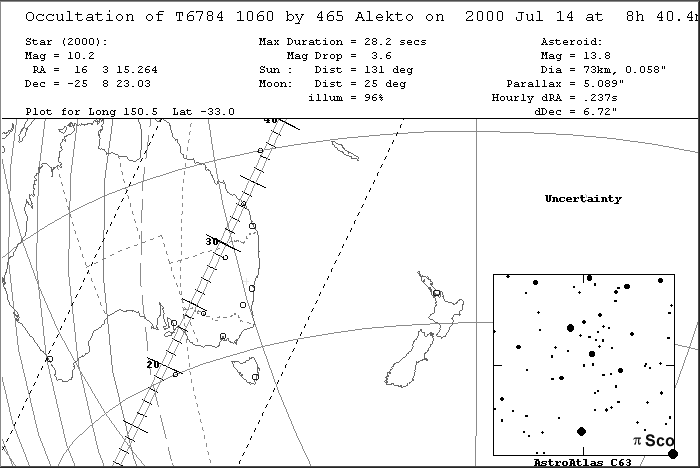CHECK THIS PAGE REGULARLY FOR FURTHER UPDATES AND CHANGES TO THE TRACK.
YOU MUST RELOAD THIS PAGE USING YOUR BROWSER'S
RELOAD/REFRESH BUTTON TO OBTAIN UPDATES!
This prediction update has been computed by Stephen Kerr based on astrometry from Ron Stone of the US Naval Observatory - Flagstaff Station. The Tycho-1 position of the target star has been used.
Summary:
This update indicates a small shift of around 0.5 of a path width to the north-west and around 2 minutes later relative to that given by Goffin. The new path runs just to the north of Mount Gambier (8:23 UT) and to the south-east of Mildura ( 8:25 UT). The path then runs near Nyngan (8:28 UT) in New South Wales before passing near Dalby (8:32 UT) and just to the south-east of Bundaberg in Queensland (8:33 UT). Brisbane lies very close to the path (8:32 UT) with the closest approach to Adelaide occurring at 8:23 UT. When consulting the map below, observers are urged to note that the circles near the ruled path are the actual path centreline - not the time graduated lines. !!
Of particular note for this event is the very slow movement of the asteroid. This causes this calculation to be of a rather lower accuracy than those usually derived. This slow movement also causes the unusually long expected duration for the occultation. For this reason, observers are urged to monitor this event for as long as is practicable around their expected appulse time. Both the possible interference of twilight (particularly for southern observers) and the proximity of a near full moon will also complicate the observation potentially making field identification more difficult than usual. Fortunately, the target star lies in an area populated with many bright stars. THE EVENT AT ONE GLIMPSE:

IMPORTANT NOTE!
Astrometric updates such as these should not be taken as definitive, but rather only as an indication of where the true track may lie relative to the original predicted track. Observers must bear in mind that later astrometry, in which the target star is measured in the same field as the asteroid, may still reveal substantial changes to the predicted track and time of the event. For this reason it is most important that observers far from the predicted track still monitor the event.
Use these links for further information:
[Planetary Occultations]
[Using the Predictions]
[Observing Details]
[Timing Details]
[Reporting Details]
[Report Form]
[Asteroid Occultation Results]
[Top of Page][Return to Home Page]